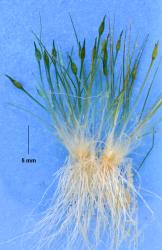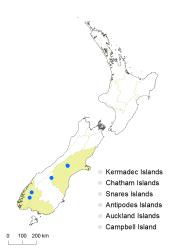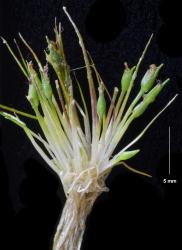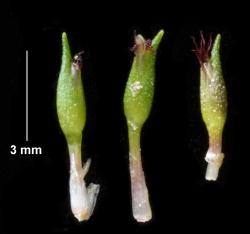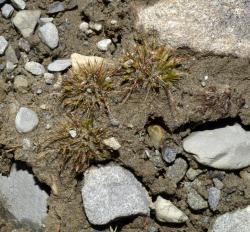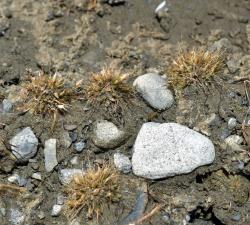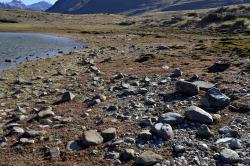- Taxon
- Gallery
- ≡ Devauxia glabra F.Muell. ex Sond., Linnaea 28: 226 (1856)
- = Alepyrum muelleri Hook.f., Bot. Antarct. Voy. III. (Fl. Tasman.) Part II, 78 (1858)
- = Centrolepis platychlamys Reader, Vict. Naturalist 23: 23 (1906)
Annual tuft, 4–30 mm high. Stem internodes condensed and not discernible. Leaves spiral, appearing radical, spreading. Leaf-sheath 1–3.5 mm long, hyaline, glabrous. Leaf-sheath auricles absent; aligulate. Leaf-lamina 2.5–24 × 0.4–0.5 mm, subulate, with an acuminate apex, terete to faintly compressed, glabrous. Uppermost leaf reduced to a membranous cataphyll. Flowering stems 1.5–14 mm long, glabrous. Inflorescence an ovoid spike, 3–4 × 0.8–1.4 mm. Outer primary floral bract 3.0–4 mm long, ovate and narrowing to a foliar point; papillate. Inner floral bract, 1.6–2.5 long mm, ovate; papillate. Internode between primary bracts absent. Secondary hyaline scales absent. Reproductive units/spike 3–6, 2 or 3 bisexual, the others female. Androecium 1 stamen; filament capillary, 2–4 mm long; anthers ellipsoid, 0.6–1 mm long. Gynoecium (2)–3–6 connate, superposed carpels. Styles stigmatic with simple papillae, crimson. Seeds, 0.5–0.6 × 0.24–0.3 mm, obovoid, yellow to yellow-brown or red-brown, faintly striated.
Distinguished from C. pallida, which is also glabrous, by a tufted habit with leaves appearing radical, whereas C. pallida forms tight cushions and has a distinctly distichous leaf arrangement. Also, C. glabra has a membranous cataphyll subtending the flowering stem, whereas in C. pallida a normal leaf subtends the flowering stem.
South Island: Spider Lakes in mid Canterbury, Ahuriri River near Snowy Gorge Creek junction in south Canterbury, Lakes Te Anau and Manapouri in Southland.
In Australia, occurring in five states: Western Australia, South Australia, New South Wales, Victoria and Tasmania (Cooke 1992).
Associated with fluctuations of shorelines of kettlehole tarns and lakes in the montane to upper montane zone from 200 to 800 m a.s.l. Initially growing below the waterline in silt or sand, or in a sandy matrix of gravel and rock, then flowering and fruiting above the receding waterline during late summer and autumn.
Flowering: Mar.-May
New Zealand plants have slightly larger seeds and longer anthers than recorded from Australian plants (Cooke 1992).



